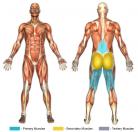Back Extensions
Performance Description
- Position your body between the foot holds and the upper thigh support.
- Using your arms to support your body on the upper thigh support, carefully position your feet into supports. Release the tension in your arms so you weight is now being supported by your muscles.
- Start with your body in a straight position (your entire body should form a straight line from head to toe).
- With your arms crossed over your chest (or behind your head), bend at the waist and lower your torso so that the top of your head is facing the ground. Go as low as you can comfortably go (which is often limited by the thigh support) .
- Slowly bring your upper torso back up to the starting position.
- Repeat steps 4-5.
Primary Muscle(s)
Hamstrings (Biceps Femoris: Short Head)
Lower Back (Paraspinal Erectors: Illiocostalis Lumborum)
Lower Back (Paraspinal Erectors: Illiocostalis Thoracis)
Lower Back (Paraspinal Erectors: Longissimus Thoracis)
Lower Back (Paraspinal Erectors: Quadratus Lumborum)
Lower Back (Paraspinal Erectors: Spinalis Thoracis)
Lower Back (Spinal Erectors: Erector Spinae)
Secondary Muscle(s)
Buttocks (Gluteus Maximus)
Hamstrings (Biceps Femoris: Long Head)
Further Clarification
This particular exercise goes by many names. You may also hear it called "Hyperextensions" or "Roman Chair".
There are a few variations available with this exercise. They are:
- The difficulty of this exercise can be increased by simply holding a weight (usually a plate) to the chest or behind the neck.
- Placing a bar across the shoulders will help to stabilize the upper back and will put additional focus on the lower part of the spinal erectors. This is not necessary, of course, but it is an available option.
- For those that find back extensions too difficult or are concerned about becoming injured, the back extension machine provides an excellent alternative. Once the torso extensions become too easy, back extensions will quite well fill in as a replacement.
Things To Look Out For
Do not extend too far past your body’s straight line of 180 degrees, this can cause hyperextension of the spine.
Level
Beginner
Exercise Position(s)
45 degree angle, 90 degree angle
Considered An Exercise In The Following Categories





